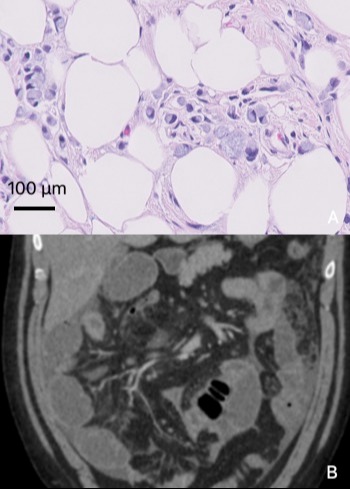Tuesday Poster Session
Category: IBD
P4443 - Crohn’s Disease Mimic: A Case Report of Signet Ring Adenocarcinoma of the Appendix
Tuesday, October 29, 2024
10:30 AM - 4:00 PM ET
Location: Exhibit Hall E

Has Audio

Manuel Garza, MD, MS
Baylor Scott & White Medical Center
Round Rock, TX
Presenting Author(s)
Manuel Garza, MD, MS1, Emma Russell, BS2, William Payne, MD3, Rajesh Shah, MD, MS4
1Baylor Scott & White Medical Center, Round Rock, TX; 2Texas A&M School of Medicine, Austin, TX; 3Baylor Scott & White Medical Center, Lakeway, TX; 4Baylor Scott & White Medical Center, Buda, TX
Introduction: Signet-ring cell adenocarcinoma (SRCA) is an aggressive form of cancer arising from mucin-producing cells often termed "linitis plastica" due to its hallmark linen-like thickening of affected tissues. Colonic SRCA can present as colonic wall thickening, bowel obstruction, and areas of sparing similar to inflammatory bowel disease (IBD) and Crohn’s disease (CD). Our reported case emphasizes SRCA as a potential mimicker of CD, which can result in delayed diagnosis.
Case Description/Methods: A 38-year-old male with no pertinent medical history presented with recurrent bowel obstruction after a recent admission for suspected CD one month prior. He denied chronic gastrointestinal symptoms such as abdominal pain, diarrhea, or hematochezia. He denied international travel or family history of IBD. He was on a steroid taper for presumed IBD flare but had no other new medications or NSAIDS. He formerly drank 6 beers daily for 5 years but quit 1 month prior. Physical exam was noncontributory, except for a distended abdomen with tenderness to palpation of the right lower quadrant, and no guarding. Labs showed an elevated C-reactive protein at 33.6 mg/L. Computed tomography of abdomen and pelvis with contrast found wall thickening and stranding of the terminal ileum. After ruling out infectious etiologies, intravenous steroids were started. Endoscopic evaluation was pursued, but he could not tolerate the bowel prep. Surgical management was planned due to recurrent bowel obstruction, and he underwent resection of the right colon and terminal ileum. Histopathology indicated a diagnosis of SRCA of the appendix.
Discussion: Case reports have shown similar presentations involving colonic metastases from SRCA of a gastric source [1]. However, a primary SRCA of the appendix is exceedingly rare [2]. There are a variety of non-infectious mimickers of Crohn’s disease, including sarcoidosis, common variable immunodeficiency, celiac disease, vasculitis, and lymphoma, alongside infectious mimickers such as mycobacterial infections, Yersinia, Clostridioides difficile, Coccidioides, and Entamoeba histolytica. While this case was limited by the inability to tolerate bowel prep for colonoscopy, the possibility of malignancy must be considered in cases of atypical bowel obstruction.

Disclosures:
Manuel Garza, MD, MS1, Emma Russell, BS2, William Payne, MD3, Rajesh Shah, MD, MS4. P4443 - Crohn’s Disease Mimic: A Case Report of Signet Ring Adenocarcinoma of the Appendix, ACG 2024 Annual Scientific Meeting Abstracts. Philadelphia, PA: American College of Gastroenterology.
1Baylor Scott & White Medical Center, Round Rock, TX; 2Texas A&M School of Medicine, Austin, TX; 3Baylor Scott & White Medical Center, Lakeway, TX; 4Baylor Scott & White Medical Center, Buda, TX
Introduction: Signet-ring cell adenocarcinoma (SRCA) is an aggressive form of cancer arising from mucin-producing cells often termed "linitis plastica" due to its hallmark linen-like thickening of affected tissues. Colonic SRCA can present as colonic wall thickening, bowel obstruction, and areas of sparing similar to inflammatory bowel disease (IBD) and Crohn’s disease (CD). Our reported case emphasizes SRCA as a potential mimicker of CD, which can result in delayed diagnosis.
Case Description/Methods: A 38-year-old male with no pertinent medical history presented with recurrent bowel obstruction after a recent admission for suspected CD one month prior. He denied chronic gastrointestinal symptoms such as abdominal pain, diarrhea, or hematochezia. He denied international travel or family history of IBD. He was on a steroid taper for presumed IBD flare but had no other new medications or NSAIDS. He formerly drank 6 beers daily for 5 years but quit 1 month prior. Physical exam was noncontributory, except for a distended abdomen with tenderness to palpation of the right lower quadrant, and no guarding. Labs showed an elevated C-reactive protein at 33.6 mg/L. Computed tomography of abdomen and pelvis with contrast found wall thickening and stranding of the terminal ileum. After ruling out infectious etiologies, intravenous steroids were started. Endoscopic evaluation was pursued, but he could not tolerate the bowel prep. Surgical management was planned due to recurrent bowel obstruction, and he underwent resection of the right colon and terminal ileum. Histopathology indicated a diagnosis of SRCA of the appendix.
Discussion: Case reports have shown similar presentations involving colonic metastases from SRCA of a gastric source [1]. However, a primary SRCA of the appendix is exceedingly rare [2]. There are a variety of non-infectious mimickers of Crohn’s disease, including sarcoidosis, common variable immunodeficiency, celiac disease, vasculitis, and lymphoma, alongside infectious mimickers such as mycobacterial infections, Yersinia, Clostridioides difficile, Coccidioides, and Entamoeba histolytica. While this case was limited by the inability to tolerate bowel prep for colonoscopy, the possibility of malignancy must be considered in cases of atypical bowel obstruction.

Figure: Figure 1.A. High power view of signet ring cells. B. CT scan with small bowel obstruction, multiple skip lesions suggested.
Disclosures:
Manuel Garza indicated no relevant financial relationships.
Emma Russell indicated no relevant financial relationships.
William Payne indicated no relevant financial relationships.
Rajesh Shah indicated no relevant financial relationships.
Manuel Garza, MD, MS1, Emma Russell, BS2, William Payne, MD3, Rajesh Shah, MD, MS4. P4443 - Crohn’s Disease Mimic: A Case Report of Signet Ring Adenocarcinoma of the Appendix, ACG 2024 Annual Scientific Meeting Abstracts. Philadelphia, PA: American College of Gastroenterology.
